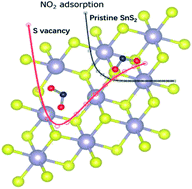Photo-enhanced gas sensing of SnS2 with nanoscale defects†
Abstract
Recently a SnS2 based NO2 gas sensor with a 30 ppb detection limit was demonstrated but this required high operation temperatures. Concurrently, SnS2 grown by chemical vapor deposition is known to naturally contain nanoscale defects, which could be exploited. Here, we significantly enhance the performance of a NO2 gas sensor based on SnS2 with nanoscale defects by photon illumination, and a detection limit of 2.5 ppb is achieved at room temperature. Using a classical Langmuir model and density functional theory simulations, we show S vacancies work as additional adsorption sites with fast adsorption times, higher adsorption energies, and an order of magnitude higher resistance change compared with pristine SnS2. More interestingly, when electron–hole pairs are excited by photon illumination, the average adsorption time first increases and then decreases with NO2 concentration, while the average desorption time always decreases with NO2 concentration. Our results give a deep understanding of photo-enhanced gas sensing of SnS2 with nanoscale defects, and thus open an interesting window for the design of high performance gas sensing devices based on 2D materials.



 Please wait while we load your content...
Please wait while we load your content...